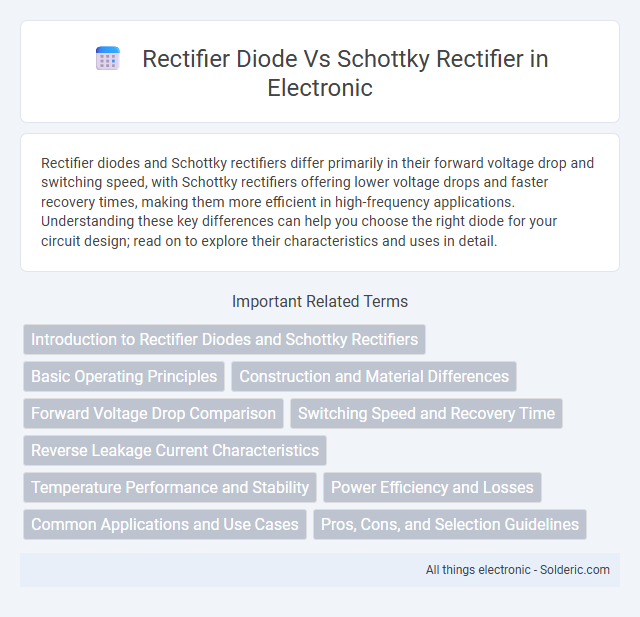Rectifier diodes and Schottky rectifiers differ primarily in their forward voltage drop and switching speed, with Schottky rectifiers offering lower voltage drops and faster recovery times, making them more efficient in high-frequency applications. Understanding these key differences can help you choose the right diode for your circuit design; read on to explore their characteristics and uses in detail.
Comparison Table
| Feature | Rectifier Diode | Schottky Rectifier |
|---|---|---|
| Material | Silicon (Si) | Metal-Semiconductor (typically Schottky barrier with Silicon) |
| Forward Voltage Drop (Vf) | 0.7V to 1.1V | 0.2V to 0.3V |
| Switching Speed | Moderate | High (fast switching) |
| Reverse Recovery Time | Longer (typically hundreds of ns) | Very short (few ns) |
| Leakage Current | Low (usually in mA range) | Higher (in mA range) |
| Power Efficiency | Lower due to higher Vf | Higher due to low Vf and fast switching |
| Applications | General purpose rectification, power supplies | High-efficiency power supplies, RF applications, low voltage, high frequency circuits |
| Cost | Lower | Higher |
Introduction to Rectifier Diodes and Schottky Rectifiers
Rectifier diodes convert alternating current (AC) to direct current (DC) by allowing current flow in one direction, with standard rectifier diodes typically using silicon-based PN junctions. Schottky rectifiers feature a metal-semiconductor junction that offers lower forward voltage drops and faster switching speeds, making them ideal for high-efficiency power applications. Your choice between these components depends on factors like switching speed, efficiency, and thermal performance requirements.
Basic Operating Principles
Rectifier diodes operate by allowing current to flow in one direction, using a p-n junction that becomes forward-biased when voltage is applied, effectively blocking reverse current. Schottky rectifiers utilize a metal-semiconductor junction instead of a p-n junction, resulting in lower forward voltage drop and faster switching speeds. Your choice between these two depends on efficiency needs and switching frequency in your electronic circuit design.
Construction and Material Differences
Rectifier diodes typically use a p-n junction made from silicon, featuring a thicker depletion region that results in higher forward voltage drops around 0.7V. Schottky rectifiers consist of a metal-semiconductor junction, usually between a metal like platinum and n-type silicon, which creates a thinner depletion layer and allows a lower forward voltage drop of approximately 0.2 to 0.3V. The construction of Schottky diodes reduces charge storage, leading to faster switching speeds compared to the bulkier silicon junction in standard rectifier diodes.
Forward Voltage Drop Comparison
A Schottky rectifier typically has a lower forward voltage drop, ranging from 0.15 to 0.45 volts, compared to the standard silicon rectifier diode's forward voltage drop of about 0.7 volts, resulting in higher efficiency and less heat generation. This lower voltage drop makes Schottky diodes ideal for high-frequency and low-voltage power applications where energy loss should be minimized. Understanding this key difference helps you select the right rectifier for improved performance in power-sensitive devices.
Switching Speed and Recovery Time
Schottky rectifiers exhibit significantly faster switching speeds and shorter recovery times than traditional rectifier diodes, making them ideal for high-frequency applications. The low forward voltage drop of Schottky diodes enhances efficiency, reducing energy loss during switching. Your power electronics circuits benefit from improved performance and reduced heat generation when using Schottky rectifiers over standard rectifier diodes.
Reverse Leakage Current Characteristics
Rectifier diodes typically exhibit lower reverse leakage current due to their PN junction structure, resulting in minimal current flow when reverse-biased. Schottky rectifiers, characterized by a metal-semiconductor junction, have higher reverse leakage current but offer faster switching speeds and lower forward voltage drop. The increased leakage in Schottky diodes impacts efficiency in high-temperature or high-voltage applications where minimal reverse leakage is critical.
Temperature Performance and Stability
Rectifier diodes typically exhibit higher temperature tolerance with junction temperatures often reaching up to 175degC, ensuring stability in high-temperature environments, whereas Schottky rectifiers operate optimally at lower temperatures, usually around 125degC, to prevent leakage current escalation. Schottky diodes demonstrate faster switching speeds and lower forward voltage drops but suffer from increased leakage currents at elevated temperatures, impacting thermal stability. In power applications demanding robust high-temperature performance, traditional rectifier diodes are preferred for their superior thermal reliability and stability over Schottky rectifiers.
Power Efficiency and Losses
Rectifier diodes typically exhibit higher forward voltage drops, resulting in greater power losses compared to Schottky rectifiers, which have lower forward voltage and faster switching capabilities. This translates to improved power efficiency in circuits using Schottky rectifiers, especially in low-voltage, high-frequency applications. Your choice of Schottky rectifiers helps minimize power dissipation and enhances overall system performance.
Common Applications and Use Cases
Rectifier diodes are commonly used in power supply circuits, converting AC to DC with high voltage resistance and moderate switching speeds ideal for general-purpose rectification in devices like adapters and chargers. Schottky rectifiers, known for their low forward voltage drop and fast switching capabilities, excel in high-efficiency power converters, RF applications, and low-voltage circuits such as solar panels and automotive electronics. Your choice depends on the application's efficiency requirements and switching speed, with Schottky diodes preferred for low-loss, high-frequency uses and standard rectifier diodes suitable for robust, high-voltage environments.
Pros, Cons, and Selection Guidelines
Rectifier diodes offer high voltage and current handling capabilities with robust thermal performance, but they have slower switching speeds and higher forward voltage drops compared to Schottky rectifiers. Schottky rectifiers excel in low forward voltage (typically 0.15-0.45V) and fast switching speed, minimizing power loss and improving efficiency in high-frequency applications, yet they have lower maximum voltage ratings and higher reverse leakage currents. Select rectifier diodes for high-voltage, high-current, and rugged applications, while Schottky rectifiers suit low-voltage, high-frequency circuits where efficiency and speed are critical.
Rectifier diode vs Schottky rectifier Infographic

 solderic.com
solderic.com